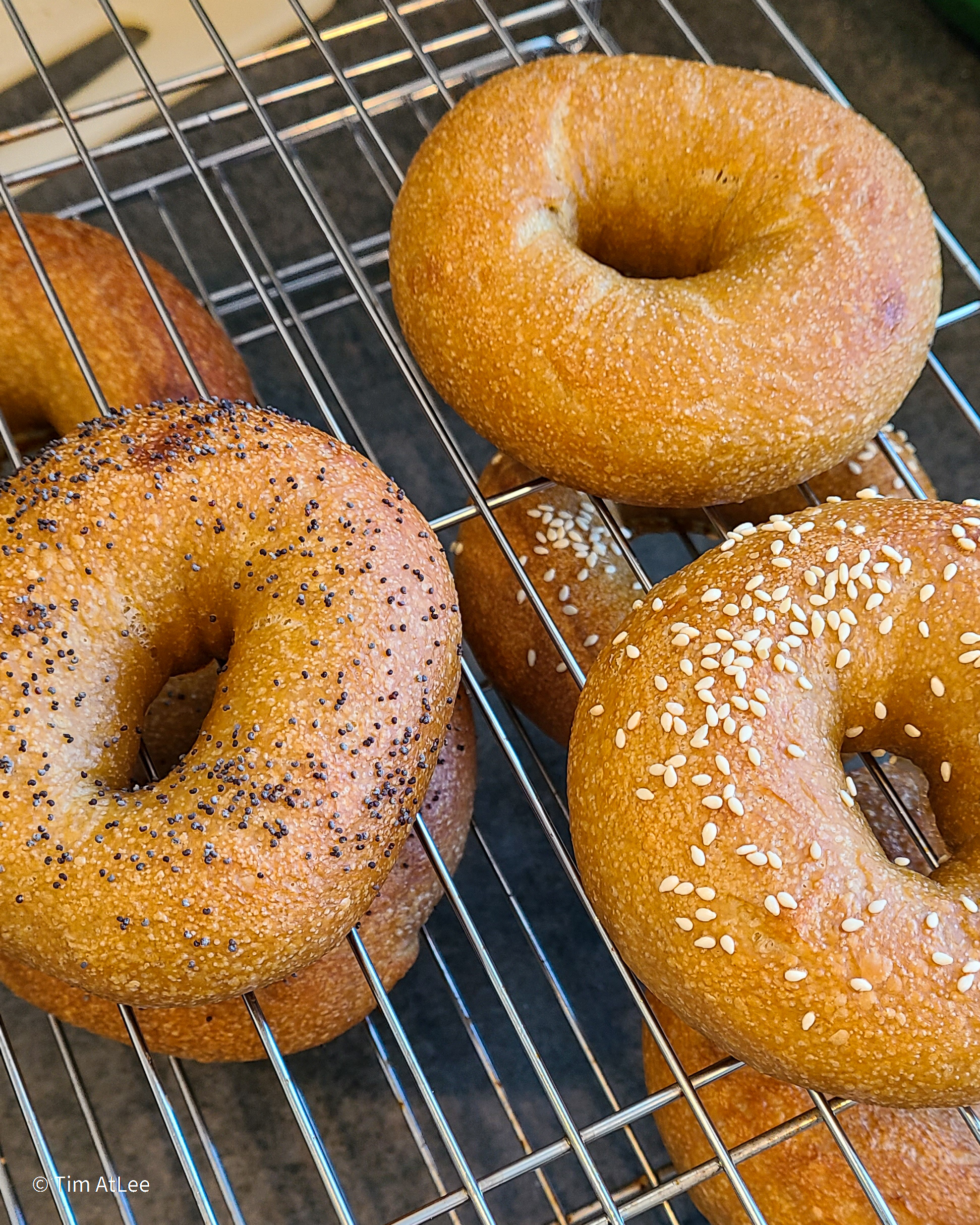Sourdough Bagels

I have been trying various bagel recipes for a while, and not having a ton of luck. A lot of them seem to come out soggy from the water bath, which leads to pancake-like donut shaped bread objects, which have a reasonable taste - have an awful texture.
So when I went to try this recipe, I was sceptical, especially not being yeasted. However, they came out really nice, with a great crumb, nice tear and a bit of an (accidentally) crunchy bottom.
I made a dozen bagels from this.
Ingredients
- 220g active sourdough starter
- 360g warm water (100°F)
- 630g Flourist Sifted Red Spring Wheat Flour
- 20g honey
- 20g molasses
- 1 Tbsp salt
You'll also need the following for the bath:
- 1/4 cup granulated sugar
- 2 tsp baking soda
Optional toppings:
- Sesame seeds
- Poppey seeds
- Salt
- etc..
Process
Early afternoon (2PM) day 1:
- Combine starter, water and flour in a bowl and mix until it becomes a shaggy mass. I did by hand, but no reason a stand mixer wouldn't work either.
- Rest for 30 minutes.
- Add salt, honey and molasses. Squeeze these ingredients in to the dough until mostly incorporated, then dump it on a floured surface and knead until smooth and elastic. I think this was 6-7 minutes.
- Transfer to a lightly oiled bowl and cover. Rest for 30 minutes.
- Stretch and fold the dough, and cover again. Rest for 30 minutes.
- Stretch and fold again, cover, and rest for an hour.
- Stretch and fold a final third time, and let rest for an hour.
- Turn the dough out and divide into 8-12 bagels, or any many (or as few) as you want. 1
- Working with each piece at a time, pinch and roll the dough into an 8" long log. Try to get the thickness as uniform as possible. Wrap the log around your 4 fingers, then overlap each end of the roll under your fingers, then roll them against the table to stick them together.
- Transfer to a heavily floured sheet pan and repeat with the remaining bagels. Leave some room for some expansion.
- Cover the pan(s) with plastic wrap and rest for 30 minutes.
- Place in the fridge overnight.
Next morning, day 2:
- Remove bagels from the fridge.
- Preheat oven to 450f.
- Fill a wide shallow pot with enough water for 2-3 bagels, and bring to a boil.
- Prepare an egg wash.
- Once the water is at a boil, reduce to medium-low and add the baking soda and sugar.
- Prepare a sheet tray with a cooling rack for draining the bagels.
- Prepare another sheet tray(s) with parchment paper for baking.
- Take a bagel and lay it carefully in the water. It should float to the top.
- Cook for 30 seconds, flip, and repeat.
- Carefully transfer to the cooling rack to drain and dry.
- Repeat with as many bagels as you can comfortably monitor.
- Transfer the bagels from the cooling track to the parchment lined sheet trays, leaving a bit of room for expansion.
- Brush with egg wash and cover with desired toppings.
- Bake for ~20 minutes, or until golden brown and tasty.
Comments
I found the flour from the fridge pans stuck to the bottom of the bagel, then made a bit of a goupy mass on the bottom of the bagel after the water path. I tried to wash this off a bit, but didn't want to manipulate the soft doughy bagels, so I just ran with it. The flour/water mass, combined with the runoff egg wash, made a surprisingly nice crunch on the bottom of the bagel that I wound up not minding.
I think if I didn't want this, I would skip the floured pans in Day 1 Step 10, and instead put them straight on parchment or maybe a cornmeal / semolina'd baking sheet. Your call.
-
Larger bagels will float better in later steps. ↩︎